Beatriz Santiago-Muñoz’s Artist Diary: Oriana
Beatriz Santiago-Muñoz’s Creative Capital project, Oriana, is a feature-length film about band of feminist militants that take refuge in a thriving Puerto Rican landscape. The film relocates Monique Wittig’s infamous novel Les Guérillères to the island in the wake of Hurricane Maria, where its protagonists work and cook, dance and rest, and prepare for battle amidst the abundant tropical vegetation.
Overcoming a hurricane and a pandemic, the production premieres Friday, October 14, 2022 at EMPAC in Troy, NY. Hear from the 2015 Creative Capital Grantee about what inspired her about this story, and how she managed to create a film in such a turbulent time.

Kryztal Rodríguez wearing a mask made by Agnes Anna Szabo in Aguas Buenas during filming of Oriana in 2020. Production Still Bleue Liverpool.
Oriana is a moving image work inspired by Les Guérillères, Monique Wittig’s 1969 experimental novel. I have been in love with this text for a very long time, since I first read it at 19. I was and still am enthralled with its way around language and form. I wanted to follow its questions into visual language and radical feminist transformation. But as I really had no answers, the work presented itself to me as an open experiment. One that I do not think has reached a resolution though this film is finished. I could not have imagined all the ways in which it would force me to rethink myself.
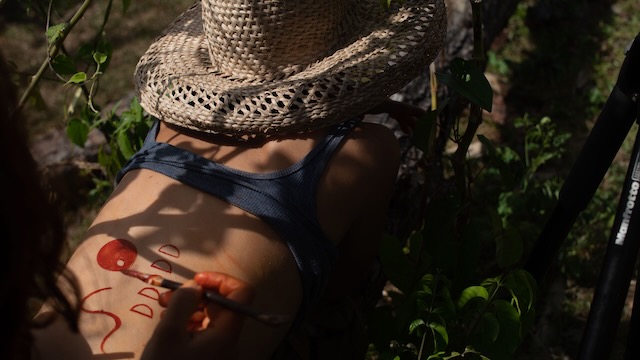
Andrea Ottenwalder in Oriana. Proudction Still, Bleue Liverpool.
Filmic narrative is built upon many of the conventions of the novel and so I have always wondered what kind of instructions this experimental work would give me if I were to follow its ideas into film. As in Les Guérillères, the warriors in Oriana are waging a war against patriarchy. There are no protagonists as such, no “character development.” Time moves in many directions. The camera pays attention to the ways in which something happens rather than to what happens. As in the novel, it is drawn to the interval. There is no interiority: no feeling, only doing. The warriors in the film have plenty of everyday work, they smell each other, sleep and receive ambiguous supernatural powers. As a viewer then, we are guided into a filmic space in which we are following a collective and unresolved movement.
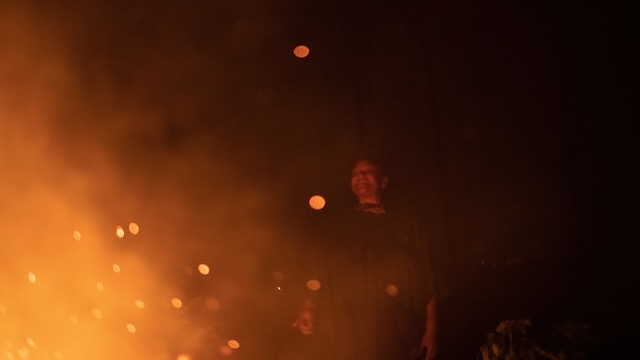
Mulowayi Iyaye Nonó in Oriana. Production still by Bleue Liverpool.
Without the funds and support of Creative Capital I would not have had the flexibility to let the work adjust and bend around two huge events: a catastrophic hurricane and the pandemic. Strangely, these obstacles forced me to find forms for the work which seem to be more connected to the novel’s experiments.

Carolina Olivares singing in Oriana. Photo by Mick Bello.
I began thinking about the production aspects of the work in 2015 when I first received Creative Capital support for the project. I shot in the way that I had imagined, trailing women whose lives I felt were real analogues of the characters in the film such as farmer Norysell Massanet and singer Macha Colón. This work was presented as a 3-channel installation at the New Museum in 2016, as part of the exhibition Song Strategy Sign, curated by Johanna Burton, Lauren Cornell, and Sara O’Keefe—themselves working in a collective form. But in September 2017, after the hurricane in Puerto Rico, many of the women I had been working with were responding to the catastrophe, their lives had been turned upside down and adding a camera to their lives felt like exploitation, as all of the cameras descending in Puerto Rico felt at the time. I decided to rethink everything and start from zero.
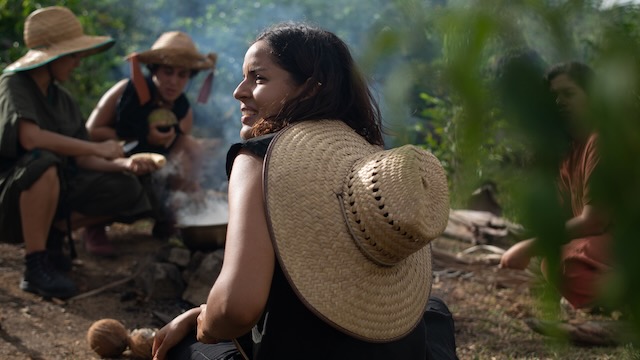
Anamarie Sierra Pagán and other members of the cast of Oriana during a break in filming in Aguas Buenas, Puerto Rico. Production Still by Bleue Liverpool.
The slim and agile production team was made up of good friends willing to rethink film production roles. Olga Casellas Badillo translated her design firm experience into a film production, and every crew member and actor worked in an organic way towards whatever was needed: cooking, bull-wrangling, driving or, importantly, the work of collective invention.
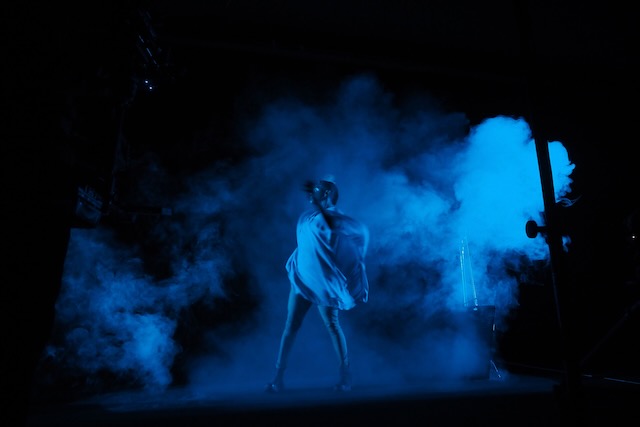 |
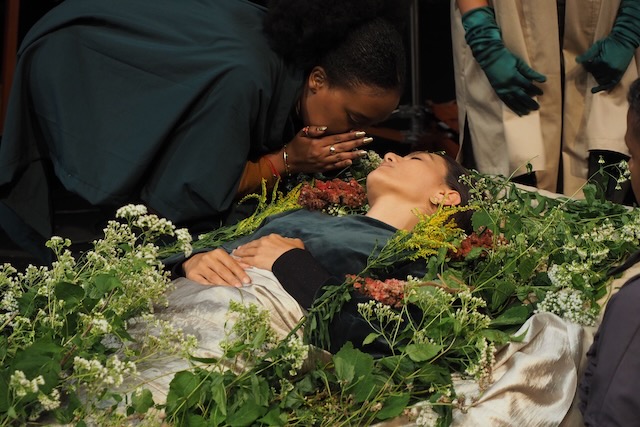 |
Left: Mapenzi Chibale Nonó in a scene shot in EMPAC. Right: Anahita Hekmat during a scene shot at EMPAC. Photos by Mick Bello.
Around this time, Vic Brooks at EMPAC invited me to think of a project that could be produced there. I adjusted some parts of the film to shoot in the studio there, and also let the structure and script go into a different direction. I was still working with non-actors and with artists, singers, writers, thinkers whose thinking and creative work intersects with the ideas in the book but we were not structuring improvisations that were integrated in any way into their day to day lives. This aspect was excised completely and this way of working was totally new to me. It was also the largest crew I have ever worked with and was a challenge to keep in mind all of the possibilities that this kind of space provides. Actors flew to Troy, NY and we spent a week improvising and filming with the EMPAC crew. This was September of 2019.
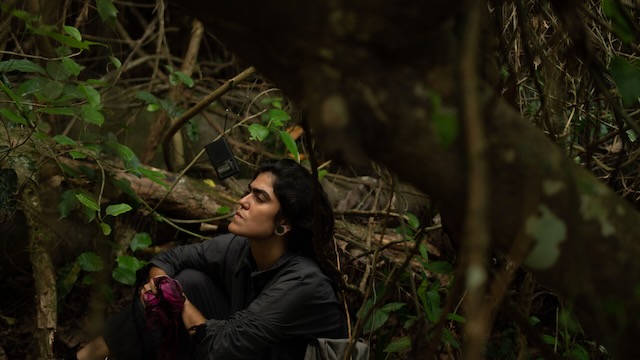
Kryztal Rodríguez in Aguas Buenas, Puerto Rico. Production still by Bleue Liverpool.
The pandemic shut everything down in Puerto Rico for many months. There was a 7pm curfew and, as elsewhere, very strict limitations on movement. Of course, this made shooting difficult, but by June we desperately needed human contact and when I invited people to all go live together on a farm in Aguas Buenas, Puerto Rico for a couple of weeks in relative isolation and to shoot the rest of the film, everyone was up for it. It was a crew and cast of twelve people in total including me. These days were beautiful. We ate well, improvised, and some people fell in love with each other. Love amid madness or fiddling on the Titanic, we weren’t sure.
 |
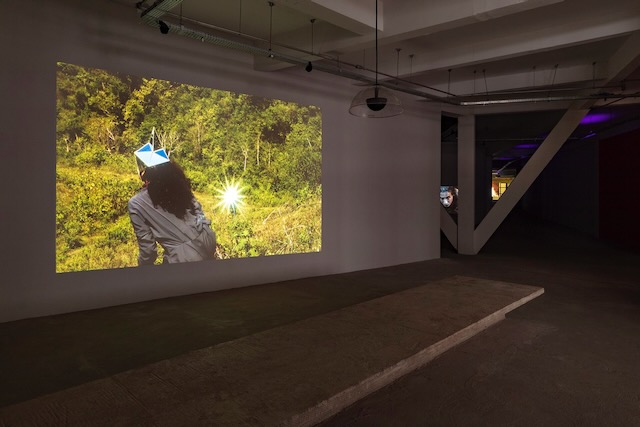 |
Left: Installation shots of the 8-channel iteration of Oriana in PIVO. Photos by Everton Ballardin.
Initially, the São Paulo-based band RAKTA was meant to come to EMPAC and compose a soundtrack for the film. The remote solution was instead to fund the work of composition in São Paulo. Coincidentally, I was invited by Fernanda Brenner to come the art space PIVO in São Paulo in September of 2021 to produce an exhibition of my work in its fabulously shaped space. I cut the film into an 8 channel work; the circularity of the path of the architecture created the timeline. The sound and language of the film changed too as, also coincidentally, a small press in São Paulo had just published a beautiful translation of Les Guérillères to Portuguese. Rather than subtitling, I recorded the many-voiced narration in Portuguese; this is the origin of the film’s multi-lingual Chorus.
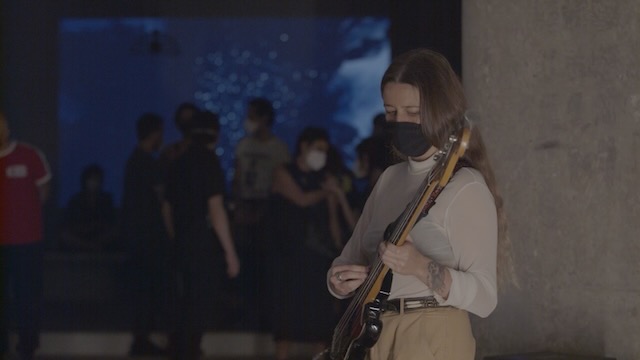
Carla Boregas of Rakta during opening of Oriana in PIVO.
Because RAKTA is based there, we were able to collaborate and improvise in a different way: the opening was a 6-hour long improvised concert in the space. An amazing experience that expanded the work’s compositional possibilities even further. It was also RAKTA’s first post-pandemic show in São Paulo where they are a band with a cult following. More than 800 people came to the show that day.
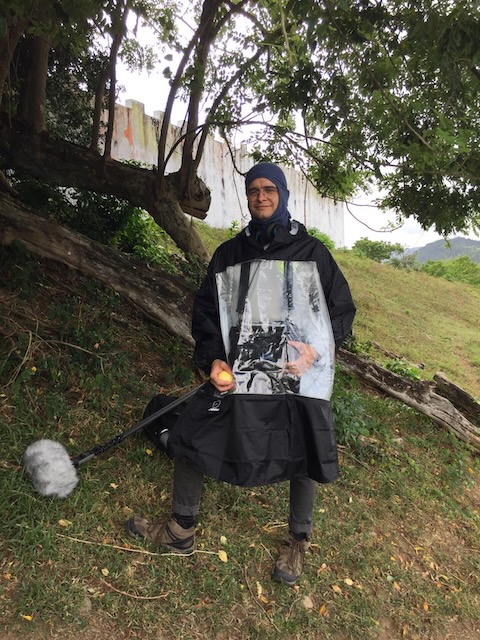
Sound recordist and designer Joel “Yoyo” Rodríguez during a break in filming Oriana in June 2020, Aguas Buenas.
In April of 2021, I was meant to go to Alsace, to the birthplace of Monique Wittig, where Elfi Turpin and the curatorial team of Crac-Alsace, an art center in Altkirch has been busy over the past few years breathing Wittig-ean ideas into the programming. But Alsace was hit very hard by the pandemic, and it also had to shut down to the public. I headed to EMPAC to edit, color correct and finish the film. In Puerto Rico I continued to work on the sound with Joel “Yoyo” Rodríguez, who has been involved with the design of the sound from the process of field recording of insects to the final mix.

The beginning of a new film based on Les Guérillères, shot in Alsace this summer.
And yet, it may sound strange, but there is another part of the work to be made. This
past summer I was able to go to Alsace where I decided not to add to this film, but to
start from zero again on another film, Oenanthe, also inspired by Les Guérillères. I have
yet to edit this film, which will be a companion to Oriana. It seems fitting then, that a
work that is inspired by Wittig, would continue even after it is finished, indicating that it is
resists resolution, and multiplying itself in a non-linear way.
Oriana premieres Friday, October 14, 2022, 8:00 PM, at EMPAC in Troy, NY. Buy tickets.
